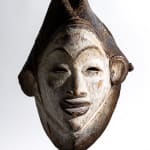Anonymous artist
Origin: Gabon
height 9 7/8 in
Further images
The white masks of the Punu from Southern Gabon are among the most cherished and emblematic African masks. Their touching naturalism endeared such masks to the Europeans who encountered them in the late 19th and early 20th centuries and inspired many avant-garde artists with their beauty and virtuosity. The okuyi dance, which gave its name to these masks, brought the community together for major events: during the funerals of its most important members, at the initiation of young men, and to restore social order after a crisis. The male okuyi dancer, accompanied by his acolytes, on such occasions danced through the village on high stilts while executing complex choreography and astonishing acrobatic stunts. The okuyi dance invoked spirits from the underworld that were incarnated as a “beautiful young girl”, designed to religiously connect the living with the dead, while capturing these occult forces. This female ancestors’ appearance was idealized in an exquisitely carved wooden mask, which corresponded with the traditional feminine Punu beauty standards. This idealized beauty is reflected wonderfully in the sensitivity of the expression. Some of the prerequisites for the masks’ life-size face were that it had to have high cheekbones, thin slit eyes, arched eyebrows, a flat nose with marked wings, full lips, and an elaborate coiffure which mirrored those worn by important Punu women in the 19th century. The majestic coiffure of the van Strien mask is composed of thin braids arranged in two shell-like forms, each of which tapers down into a side braid ending behind the ears. In an alliance between secular and religious beauty, the mask’s face is covered in mineral white pigment made from kaolin taken from riverbeds. This color was also used for body painting during collective ceremonies and was associated with the ancestral spirits, protective and beneficial for the community. The presence of this white ritual makeup therefor served as an evocation of the presence of the sacred in the profane world. This charismatic mask portraying a beautiful young Punu girl misses the typical scarification patterns on forehead and temples, imbuing its appearance with even more serenity and grace. Besides the pronounced lips with a suggestion of movement, the large projecting oval ears reveal the hand of a master carver who sculpted two more masks with these particular features: one collected by the French colonial administrator Octave Mariani between 1913-1923 (cf. Native Auctions, Brussels, 15 May 2021, lot 76) and another collected by René Labat between 1912 and 1920 and offered for sale by Bernard Dulon in 2007, firmly placing the creation date of this mask in the early years of the 20th century. Although the efficiency of its powers was originally asserted in the glimpse of the spectacular okuyi dance performances, this mask still mesmerizes us today with the serenity of its sculpted face.
Provenance
Harvey Menist, Amsterdam
Philippe Guimiot, Brussels, 1974
Cees Van Strien Collection
By descent through family, 2022







